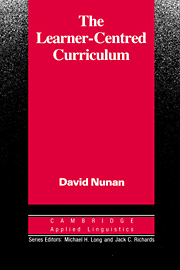Book contents
- Frontmatter
- Contents
- Series Editors' Preface
- Preface
- 1 Introduction
- 2 Curriculum Processes
- 3 Learner-Centred Curriculum Development
- 4 Pre-Course Planning Procedures
- 5 Planning Content
- 6 Methodology
- 7 Resources for a Learner-Centred Curriculum
- 8 Assessment and Evaluation
- 9 Evaluation and Professional Development
- 10 The Teacher as Curriculum Developer
- References
- Appendix
- Subject Index
- Author Index
8 - Assessment and Evaluation
Published online by Cambridge University Press: 05 April 2013
- Frontmatter
- Contents
- Series Editors' Preface
- Preface
- 1 Introduction
- 2 Curriculum Processes
- 3 Learner-Centred Curriculum Development
- 4 Pre-Course Planning Procedures
- 5 Planning Content
- 6 Methodology
- 7 Resources for a Learner-Centred Curriculum
- 8 Assessment and Evaluation
- 9 Evaluation and Professional Development
- 10 The Teacher as Curriculum Developer
- References
- Appendix
- Subject Index
- Author Index
Summary
The Place of Evaluation in the Curriculum
No curriculum model would be complete without an evaluation component. While it is universally recognised as an essential part of any educational endeavour, it is the component about which most classroom practitioners generally claim the least knowledge, and is the one area of the curriculum about which many teachers express a lack of confidence. In this chapter it will be argued that in a learner-centred curriculum model both teachers and learners need to be involved in evaluation. It will also be argued that self-assessment by learners can be an important supplement to teacher assessment and that self-assessment provides one of the most effective means of developing both critical self-awareness of what it is to be a learner, and skills in learning how to learn.
Evaluation can, in fact, occur at various levels. At a macro-level national and state programmes can be evaluated. At this level evaluation will probably focus on administration and be carried out largely by personnel with evaluation expertise. Local, or centre-level, evaluation will be more circumscribed and involve administrators and teachers.
Micro-evaluation is conducted at the classroom level and involves teachers and learners.
Here we shall be principally concerned with evaluation at the microlevel, and the relatively informal evaluation techniques and procedures described in the latter part of this chapter are designed for use by teachers and learners at the classroom level.
- Type
- Chapter
- Information
- The Learner-Centred CurriculumA Study in Second Language Teaching, pp. 116 - 135Publisher: Cambridge University PressPrint publication year: 1988



